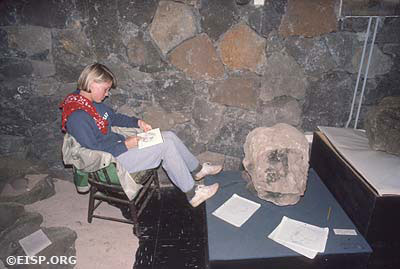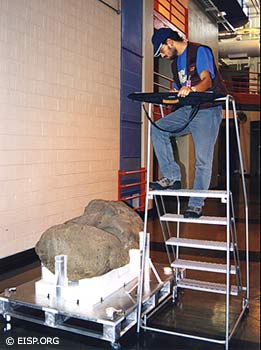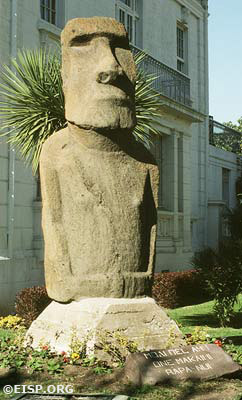Documenting Objects in Museums and Collections

Lynn Lockie documenting a moai head at the Englert Museum, Hanga Roa, Rapa Nui. ©1984 EISP/JVT/ Photo: D. C. Ochsner.
Following the work of Lynn Lockie in 1984, EISP expanded to include museum collections research. Statues, fragments, pukao and portable stone sculpture have been documented using the same attribute list that was applied to moai in archaeological contexts. Ten intact moai, as well as 55 other stone sculptural objects including moai heads, torsos, pukao and fragments from major museums in the US, the UK, Chile, New Zealand, France, Belgium and Canada are now included in the EISP database. These objects have been culled from more than double that number that we have examined, and represent objects with the best documented provenance and what we consider to be the greatest formal relevance to moai design and chronology.
Beginning in 1992, Cristián Arévalo Pakarati produced finished drawings of the most important of these objects in the island museum and on the Chilean mainland. Some of those drawings were included in Van Tilburg’s first paper for the British Museum, “HMS Topaze on Easter Island: Hoa Hakananai’a and Five Other Museum Statues in Archaeological Context” (British Museum Press, 1992). From 2000 to the present, Van Tilburg and Arévalo Pakarati have conducted further research at the British Museum; the National Library of Scotland and the Scottish National Museum in Edinburgh; the Ulster Museum in Belfast; the Pitt Rivers Museum in Oxford and, in the US, at the Peabody Museum, Cambridge; the Smithsonian Institution; the American Museum of Natural History, NYC; the Metropolitan Museum of Art, Chicago’s Field Museum of Natural History and elsewhere.
These studies are unique adjuncts to EISP field work, and are the direct result of the generous and helpful collaboration we have received from all museums and every curator and their staff with whom we have come in contact. Our research goal is to seek antecedents and design variants of the Rapanui stonecarving aesthetic, and to establish a chronology of design vocabulary. In the process, we hope to re-insert the moai that have been taken from the island back into archaeological contexts, thus re-integrating each object with its unique history. This research has been especially enlightening in the case of the two moai in the British Museum (collected in 1868) and the moai and moai head in the National Museum of Natural History, Smithsonian Institution (collected in 1886). All four of these important objects, and the sites from which they were taken, are now better understood. In Van Tilburg’s forthcoming “Remote Possibilities: HMS Topaze and Hoa Hakananai’a on Easter Island” (British Museum Press, 2005), the comprehensive results of the first stage of this study are outlined. Further work, including stone sourcing, is anticipated.
Want to know more?
Van Tilburg, J. 2005. Remote Possibilities: HMS Topaze and Hoa Hakananai’a on Easter Island. Research Paper 158. London: The British Museum Press.
Van Tilburg, J. 2004. Objects in Focus: Hoa Hakananai’a. London: The British Museum Press.
 English
English  Español
Español 

